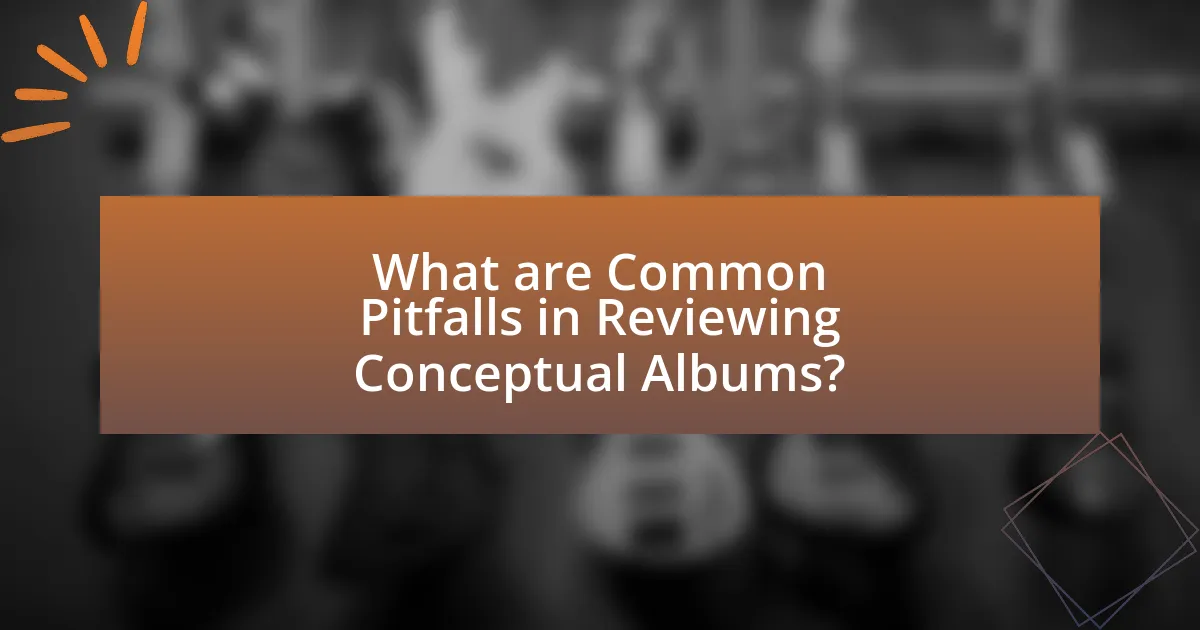Conceptual albums are musical works centered around a cohesive theme or narrative, allowing artists to delve into complex ideas and emotions. This article examines the significance of conceptual albums, highlighting their differences from traditional albums, the elements that define them, and how narratives shape the listening experience. It also addresses the challenges reviewers face when analyzing these albums, including the impact of thematic complexity and the importance of context. Best practices for reviewing conceptual albums are outlined, emphasizing the need for structured analysis and awareness of biases to ensure fair assessments.

What are Conceptual Albums and Why are They Significant?
Conceptual albums are musical works that revolve around a central theme or narrative, creating a cohesive artistic statement throughout the collection of songs. They are significant because they allow artists to explore complex ideas, emotions, and stories in a structured format, enhancing the listener’s experience and engagement. Notable examples include Pink Floyd’s “The Wall,” which addresses themes of isolation and societal pressures, and The Who’s “Tommy,” a rock opera that tells a story through its tracks. These albums often push the boundaries of traditional music formats, encouraging innovation in songwriting and production techniques.
How do Conceptual Albums differ from Traditional Albums?
Conceptual albums differ from traditional albums primarily in their thematic coherence and narrative structure. While traditional albums typically consist of standalone songs that may or may not relate to each other, conceptual albums are designed around a central theme or story that connects all tracks, creating a unified artistic statement. For example, Pink Floyd’s “The Wall” serves as a narrative exploring themes of isolation and alienation, illustrating how each song contributes to the overarching concept. This intentional design in conceptual albums often leads to a more immersive listening experience, as the audience engages with the album as a complete work rather than a collection of individual songs.
What elements define a Conceptual Album?
A conceptual album is defined by its cohesive narrative or thematic structure that connects the songs, creating a unified artistic statement. This structure often includes recurring motifs, characters, or storylines that guide the listener through the album’s progression. For instance, Pink Floyd’s “The Wall” exemplifies this by exploring themes of isolation and alienation through its lyrics and musical transitions, effectively illustrating how the songs interrelate to convey a larger message. Additionally, conceptual albums frequently employ musical techniques such as interludes or soundscapes that enhance the storytelling aspect, further solidifying their identity as a cohesive work rather than a collection of unrelated tracks.
How do narratives shape the listening experience of Conceptual Albums?
Narratives significantly shape the listening experience of conceptual albums by providing a cohesive storyline that guides the listener through the music. This structured narrative framework enhances emotional engagement, as listeners can connect with the characters, themes, and events presented in the album. For instance, Pink Floyd’s “The Wall” uses a narrative to explore themes of isolation and trauma, allowing listeners to experience the protagonist’s journey on a deeper level. Research indicates that albums with strong narratives can lead to increased listener retention and emotional response, as evidenced by studies showing that storytelling in music can evoke stronger emotional reactions compared to non-narrative compositions.
What challenges do reviewers face when analyzing Conceptual Albums?
Reviewers face several challenges when analyzing conceptual albums, primarily due to the complexity of narrative structures and thematic depth. Conceptual albums often weave intricate stories or explore abstract themes, making it difficult for reviewers to distill the core message and evaluate the artistic intent. Additionally, the subjective nature of interpretation can lead to varied opinions on the album’s meaning, complicating consensus among critics. The reliance on musical cohesion to support the overarching concept also poses a challenge, as reviewers must assess both individual tracks and their contribution to the whole. Furthermore, the lack of explicit context or guidance from the artist can leave reviewers navigating ambiguity, which may hinder their ability to provide a comprehensive analysis.
How does the complexity of themes impact album reviews?
The complexity of themes significantly impacts album reviews by influencing the depth of analysis and interpretation required from critics. When an album presents intricate themes, reviewers must engage more critically with the content, often exploring multiple layers of meaning, which can lead to more nuanced and detailed reviews. For instance, albums like “The Wall” by Pink Floyd, which tackles complex issues such as isolation and societal pressure, receive reviews that delve into these themes, providing readers with a richer understanding of the work. This complexity can also lead to varied interpretations among critics, as seen in the diverse responses to Kendrick Lamar’s “To Pimp a Butterfly,” where themes of race and identity prompted extensive discussion and analysis. Thus, the thematic complexity of an album directly correlates with the depth and variety of insights presented in its reviews.
What role does the artist’s intent play in the review process?
The artist’s intent significantly influences the review process by providing context and meaning to the work being evaluated. Understanding the creator’s purpose helps reviewers assess how effectively the album communicates its themes and concepts. For instance, if an artist aims to explore social issues through their music, reviewers can analyze the lyrics and instrumentation in light of this intent, leading to a more nuanced critique. This approach aligns with established practices in music criticism, where intent is often considered a key factor in evaluating artistic merit and coherence.
Why is context important in reviewing Conceptual Albums?
Context is important in reviewing conceptual albums because it provides the necessary background to understand the artist’s intentions and the thematic elements of the work. Conceptual albums often explore complex narratives or ideas that are deeply rooted in specific cultural, historical, or personal contexts. For instance, Pink Floyd’s “The Wall” reflects the socio-political climate of the 1970s and the personal struggles of its members, which enhances the listener’s comprehension of its themes. Without this context, reviewers may misinterpret the album’s message or overlook significant layers of meaning, leading to a superficial analysis. Therefore, understanding the context allows for a more nuanced and accurate evaluation of the album’s artistic merit and relevance.
How do historical and cultural contexts influence interpretation?
Historical and cultural contexts significantly influence interpretation by shaping the meanings and values associated with artistic works. For instance, a conceptual album released during a period of social upheaval may be interpreted differently than one released in a time of stability, as listeners draw connections between the content and their contemporary experiences. The cultural background of the audience also plays a crucial role; for example, an album that references specific historical events may resonate more deeply with listeners familiar with those events, while others may miss critical nuances. This dynamic is evident in the analysis of works like Kendrick Lamar’s “To Pimp a Butterfly,” which reflects the African American experience and addresses systemic racism, leading to varied interpretations based on the listener’s own cultural and historical context.
What external factors should reviewers consider?
Reviewers should consider the cultural context, historical significance, and audience reception when evaluating conceptual albums. Cultural context influences the themes and messages within the album, while historical significance can provide insight into its impact on the music industry or society at large. Audience reception, including critical reviews and fan reactions, can indicate how well the album resonates with listeners and its relevance in contemporary music discussions. These factors collectively enhance the review’s depth and accuracy, ensuring a comprehensive understanding of the album’s place within the broader musical landscape.

What Best Practices Should Reviewers Follow for Conceptual Albums?
Reviewers should analyze the narrative structure and thematic coherence of conceptual albums to provide insightful critiques. This involves understanding the overarching story or concept that the album conveys, as many conceptual albums are designed to be experienced as a whole rather than through individual tracks. For instance, Pink Floyd’s “The Wall” exemplifies a cohesive narrative that reviewers must consider when evaluating its artistic intent. Additionally, reviewers should pay attention to the musical elements that support the concept, such as instrumentation, lyrics, and production techniques, as these contribute significantly to the overall impact of the album. By focusing on these aspects, reviewers can deliver a comprehensive analysis that reflects the complexity and artistry inherent in conceptual works.
How can reviewers effectively communicate their insights?
Reviewers can effectively communicate their insights by using clear, structured language and providing specific examples from the album. This approach ensures that their observations are easily understood and relatable to the audience. For instance, when discussing thematic elements, reviewers should cite particular lyrics or musical motifs that illustrate their points, thereby grounding their insights in concrete evidence. Research indicates that structured feedback, which includes both positive and critical elements, enhances the clarity and impact of reviews, making them more useful for readers seeking to understand the album’s nuances.
What writing techniques enhance the clarity of reviews?
Writing techniques that enhance the clarity of reviews include using clear and concise language, structuring content logically, and employing specific examples. Clear and concise language eliminates ambiguity, making it easier for readers to understand the review’s main points. Structuring content logically, such as using headings and bullet points, helps guide the reader through the review systematically. Specific examples, such as citing particular songs or themes from the album, provide concrete evidence that supports the reviewer’s opinions, making the analysis more relatable and understandable. These techniques collectively improve the overall effectiveness of the review by ensuring that the reader can easily grasp the key insights being presented.
How can reviewers balance subjective and objective analysis?
Reviewers can balance subjective and objective analysis by integrating personal insights with factual evidence. This approach involves articulating personal interpretations of the album while supporting those views with specific examples, such as lyrical content, production techniques, and historical context. For instance, a reviewer might express a subjective opinion about an album’s emotional impact and then substantiate that opinion by referencing particular tracks that exemplify the emotional themes. This method ensures that the review remains grounded in both personal experience and objective criteria, allowing for a comprehensive evaluation that resonates with a diverse audience.
What tools and resources can aid in the review process?
Tools and resources that can aid in the review process of conceptual albums include music analysis software, collaborative platforms, and reference materials. Music analysis software, such as Sonic Visualiser, allows reviewers to dissect audio tracks for elements like tempo, key, and structure, enhancing understanding of the album’s composition. Collaborative platforms like Google Docs enable multiple reviewers to provide feedback simultaneously, streamlining the review process. Additionally, reference materials, including scholarly articles and interviews with artists, provide context and insights that enrich the review, ensuring a well-rounded perspective on the conceptual themes presented in the album.
Which analytical frameworks are useful for dissecting Conceptual Albums?
Analytical frameworks useful for dissecting conceptual albums include narrative analysis, thematic analysis, and semiotic analysis. Narrative analysis examines the storyline and character development within the album, allowing for a deeper understanding of the overarching narrative structure. Thematic analysis identifies recurring themes and motifs, which can reveal the underlying messages and concepts the artist aims to convey. Semiotic analysis focuses on the signs and symbols used in the album, providing insight into how meaning is constructed through various elements such as lyrics, music, and visual art. These frameworks are validated by their widespread application in musicology and cultural studies, demonstrating their effectiveness in analyzing complex artistic works.
How can collaboration with other reviewers enhance understanding?
Collaboration with other reviewers enhances understanding by facilitating diverse perspectives and insights on conceptual albums. When multiple reviewers share their interpretations and analyses, they can uncover nuances and themes that an individual reviewer might overlook. Research indicates that collaborative discussions lead to richer, more comprehensive evaluations, as evidenced by studies showing that group analysis often results in a deeper understanding of complex subjects. This collective approach not only broadens the scope of interpretation but also fosters critical thinking and encourages reviewers to challenge their own biases, ultimately leading to a more informed and holistic review process.

What are Common Pitfalls in Reviewing Conceptual Albums?
Common pitfalls in reviewing conceptual albums include failing to grasp the overarching narrative, which can lead to misinterpretation of the artist’s intent. Reviewers often focus on individual tracks rather than the album as a cohesive whole, neglecting the thematic connections that define conceptual works. Additionally, some reviewers may overlook the importance of context, such as the cultural or historical background of the album, which can significantly influence its meaning. Another common issue is the tendency to apply conventional album review standards, which may not be suitable for the unique structure and storytelling approach of conceptual albums. These pitfalls can result in a superficial analysis that does not do justice to the complexity and artistry involved in such projects.
What biases should reviewers be aware of?
Reviewers should be aware of confirmation bias, cultural bias, and personal bias. Confirmation bias occurs when reviewers favor information that confirms their pre-existing beliefs about an album, potentially leading to skewed evaluations. Cultural bias can influence reviewers’ interpretations based on their own cultural backgrounds, affecting their understanding of the album’s themes and messages. Personal bias arises from reviewers’ individual preferences and experiences, which may cloud their judgment and objectivity. Recognizing these biases is crucial for providing fair and balanced reviews of conceptual albums.
How can personal preferences skew the review of a Conceptual Album?
Personal preferences can skew the review of a conceptual album by influencing the reviewer’s interpretation and emotional response to the music. For instance, if a reviewer has a strong affinity for a particular genre or artist, they may overlook flaws or biases in their analysis, leading to an overly positive review. Conversely, a reviewer with a negative bias towards a genre may focus on perceived shortcomings, resulting in a harsh critique. Research indicates that subjective experiences significantly impact music perception, as demonstrated in studies like “The Role of Personal Preferences in Music Evaluation” by North and Hargreaves, which found that individual tastes can alter the perceived quality of music. This highlights how personal biases can distort objective assessment, ultimately affecting the overall reception of a conceptual album.
What misconceptions about Conceptual Albums should be avoided?
One misconception about conceptual albums is that they must have a linear narrative structure. In reality, many conceptual albums employ non-linear storytelling or abstract themes, allowing for diverse interpretations. For example, Pink Floyd’s “The Wall” presents a fragmented narrative that explores psychological themes rather than a straightforward story. Another misconception is that all songs in a conceptual album must be directly related to the central theme; however, artists often include tracks that serve as interludes or explorations of related ideas, as seen in David Bowie’s “The Rise and Fall of Ziggy Stardust and the Spiders from Mars.” Understanding these nuances helps listeners appreciate the artistic intent behind conceptual albums.
How can reviewers ensure a fair assessment of Conceptual Albums?
Reviewers can ensure a fair assessment of conceptual albums by establishing clear criteria that focus on the album’s thematic coherence, narrative structure, and artistic intent. By analyzing how well the album communicates its concept through lyrics, instrumentation, and overall production, reviewers can provide a balanced evaluation. For instance, a study published in the Journal of Music Theory highlights that thematic consistency is crucial for understanding the artistic vision behind conceptual works, emphasizing the need for reviewers to engage deeply with the material rather than relying solely on personal taste.
What strategies can help mitigate bias in reviews?
To mitigate bias in reviews, employing structured evaluation criteria is essential. This approach involves creating a standardized rubric that focuses on specific aspects of the album, such as lyrical content, musical composition, and thematic coherence. Research indicates that using a rubric can lead to more objective assessments, as it minimizes personal biases and subjective interpretations. For instance, a study published in the Journal of Music Theory demonstrated that reviewers who utilized structured criteria provided more consistent evaluations compared to those who relied solely on personal impressions. Additionally, incorporating diverse perspectives by involving multiple reviewers can further reduce individual biases, as collaborative assessments tend to balance out personal preferences and viewpoints.
How can reviewers remain open to diverse interpretations?
Reviewers can remain open to diverse interpretations by actively engaging with multiple perspectives and avoiding preconceived notions. This approach allows them to appreciate the various meanings that a conceptual album may convey, as evidenced by studies showing that diverse viewpoints enhance critical analysis and understanding. For instance, research published in the Journal of Musicology highlights that reviewers who consider different cultural and contextual backgrounds are more likely to uncover nuanced interpretations, thereby enriching their reviews.
What practical tips can enhance the review of Conceptual Albums?
To enhance the review of conceptual albums, reviewers should focus on understanding the overarching narrative and themes presented in the album. This involves actively listening to the album multiple times to grasp the nuances of the storyline and how each track contributes to the overall concept. Additionally, researching the artist’s background and previous works can provide context that enriches the review. For instance, examining interviews or statements from the artist about their intentions can clarify the themes and messages they aim to convey. Furthermore, comparing the album to other conceptual works can highlight its uniqueness and effectiveness in storytelling. These strategies ensure a comprehensive and insightful review that resonates with both casual listeners and dedicated fans.
How can a structured approach improve the review process?
A structured approach can improve the review process by providing a clear framework that enhances consistency and objectivity in evaluations. This framework allows reviewers to systematically assess various elements of conceptual albums, such as thematic coherence, musical composition, and lyrical depth, ensuring that all relevant aspects are considered. Research indicates that structured methodologies, like rubric-based assessments, lead to more reliable outcomes, as they minimize subjective biases and promote thorough analysis. For instance, a study published in the Journal of Educational Psychology found that structured feedback significantly improved the quality of peer reviews by providing specific criteria for evaluation, which can be directly applied to the review of conceptual albums.
What are effective ways to engage readers with Conceptual Album reviews?
Effective ways to engage readers with Conceptual Album reviews include providing a clear narrative that connects the album’s themes to broader cultural or personal contexts. This approach helps readers understand the significance of the album beyond its music. Additionally, incorporating quotes from the artist or relevant interviews can add authenticity and depth to the review. Engaging readers also involves using vivid descriptions of the music and its emotional impact, which can evoke a stronger connection. Furthermore, inviting readers to share their interpretations or experiences related to the album fosters a sense of community and interaction. These strategies are supported by research indicating that narrative engagement increases reader interest and retention, as seen in studies on music journalism and audience engagement.
